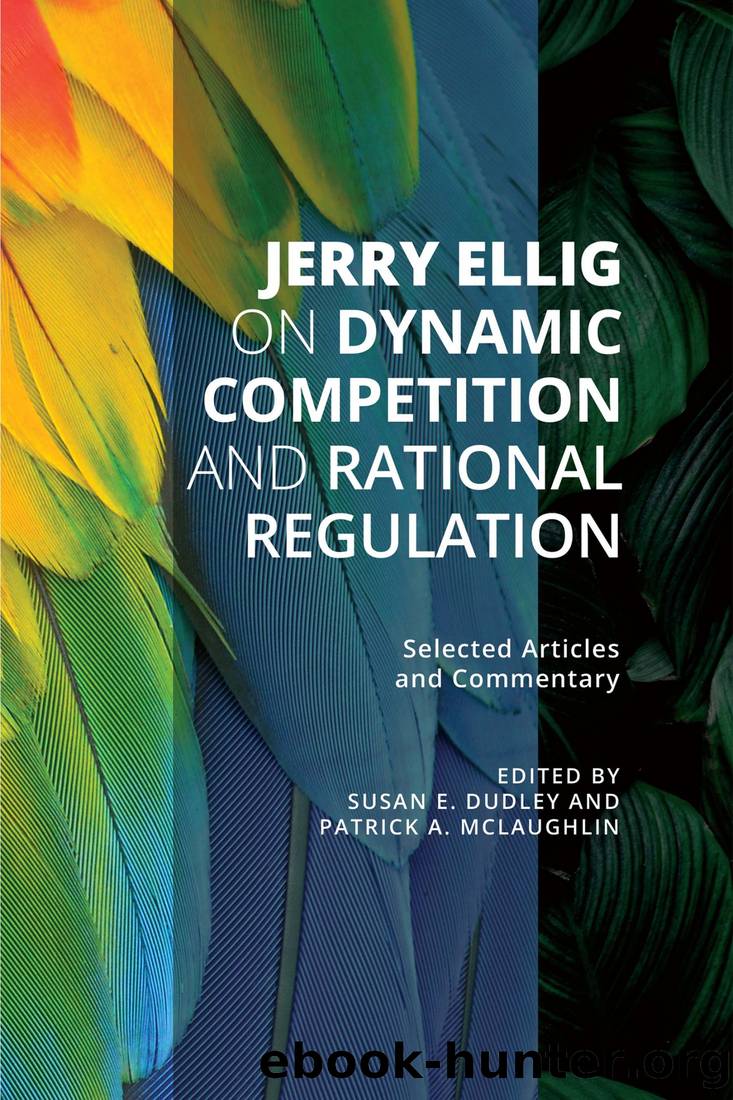Jerry Ellig on Dynamic Competition and Rational Regulation by Jerry Ellig

Author:Jerry Ellig [Ellig, Jerry]
Language: eng
Format: epub
ISBN: 9781942951674
Publisher: GeorgeMasonUP
Published: 0101-01-01T00:00:00+00:00
V. IMPORTANT TRENDS IN REGULATION
Five important trends in regulation are essential to understand. The first major trend is a reduction in certain types of economic regulation. Many graphs of federal spending on industry-specific economic regulation come from a publication called the Regulatorâs Budget. This is jointly assembled every year and updated by the Mercatus Center and the Weidenbaum Center at Saint Louis University.11 Money spent on industry-specific economic regulation increased throughout the sixties, but in the seventies it started falling. It bounced up a little bit, and then bounced down, but a big drop-off persisted throughout the 1970s and into the 1980s.
These trends largely reflect the decisions to deregulate prices and entry in transportation industries like railroads, trucking, airlines, communications, telecommunications, and certain energy industries. For example, the federal government no longer controls the price of natural gas. The price is set through competition in the market. Much of the scholarly research in the 1960s and the 1970s on a cluster of infrastructure industries demonstrated that the principal effect of government regulation in these competitive industries was to enforce cartels, enforce monopolies, and overcharge consumers. This is why the two principal political figures who pushed the deregulation of those industries in the 1970s, particularly the transportation industry, were President Jimmy Carter and Senator Ted Kennedy. Senator Ted Kennedy was the principal sponsor of the airline deregulation bill.
The figures on regulatory personnel show a similar effect because there was a big reduction of regulatory personnel who were involved in industry-specific regulation. Almost all of the academic research, whether it is by economists who are on the left, the right, or in the middle, agreed on the impact of this regulation. In studies by the Brookings Institution in Washington, DC, economists suggested that deregulation benefits consumers with large price decreases and other significant benefits, such as improvements in the quality and timeliness of service. When economists have quantified the effects in 1995 dollars, it totaled around $60 billion per year. At current prices, these figures rise to approximately $75 to $80 billion in annual benefits that consumers get from lower prices and better service as a result of the deregulation that has occurred in these industries. This is driving the reduction in spending and personnel on economic regulation.
The OMBâs guidance documents for regulatory agencies also encapsulate the conventional wisdom of economists with regard to government regulation of prices. In terms of service in competitive industries, the OMB guidance to agencies says, âin light of both economic theory and actual experience a particularly demanding burden of proof is required to demonstrate the need for any of the following types of regulations.â12 Essentially, regulations of prices, quantities, quotas, and aspects of industries could be competitive. The highest levels of officials in the federal government who review federal regulation accept that economic regulation that puts government in the business of enforcing cartels and monopolies does not benefit consumers. Such types of regulation should raise suspicions, unless there is some other public interest or reason besides the effects on prices and consumer welfare.
Download
This site does not store any files on its server. We only index and link to content provided by other sites. Please contact the content providers to delete copyright contents if any and email us, we'll remove relevant links or contents immediately.
Bad Blood by John Carreyrou(6559)
Rich Dad Poor Dad by Robert T. Kiyosaki(6414)
Principles: Life and Work by Ray Dalio(6233)
Playing to Win_ How Strategy Really Works by A.G. Lafley & Roger L. Martin(5941)
Management Strategies for the Cloud Revolution: How Cloud Computing Is Transforming Business and Why You Can't Afford to Be Left Behind by Charles Babcock(4528)
The Confidence Code by Katty Kay(4190)
Thinking in Bets by Annie Duke(4154)
American Kingpin by Nick Bilton(3761)
Delivering Happiness by Tony Hsieh(3369)
Project Animal Farm: An Accidental Journey into the Secret World of Farming and the Truth About Our Food by Sonia Faruqi(3179)
The Power of Habit by Charles Duhigg(3063)
The Tyranny of Metrics by Jerry Z. Muller(3008)
Brotopia by Emily Chang(3002)
Mastering Bitcoin: Programming the Open Blockchain by Andreas M. Antonopoulos(2983)
The Marketing Plan Handbook: Develop Big-Picture Marketing Plans for Pennies on the Dollar by Robert W. Bly(2978)
I Live in the Future & Here's How It Works by Nick Bilton(2940)
The Content Trap by Bharat Anand(2864)
Building a StoryBrand by Donald Miller(2844)
Applied Empathy by Michael Ventura(2839)
